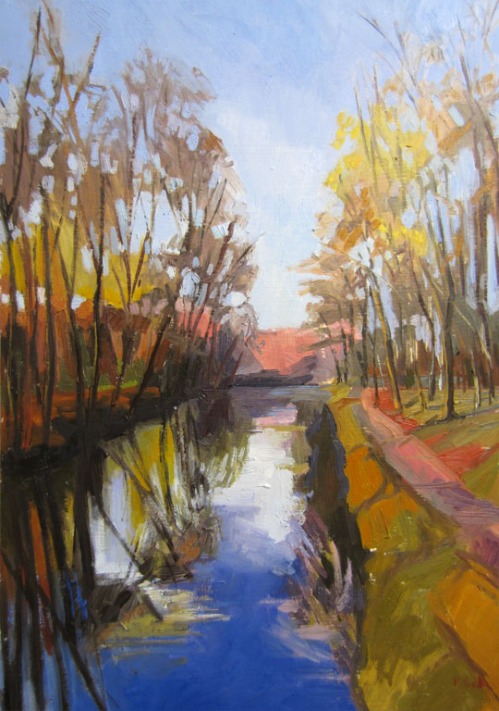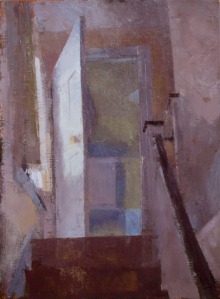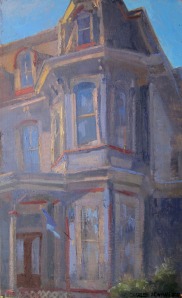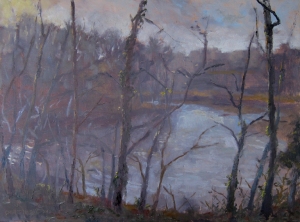
Kate Kern Mundie, City Hall in Fog, 14 x 12 inches, oil on panel
Kate Kern Mundie is exhibiting 30 paintings at F.A.N. Gallery for the month of December. Her work in this exhibition is a mixture of landscape, still life, and interiors.
Q: How would you describe your work? What inspires you to put brush to surface?
A: I paint because I like to lose myself in the experience of painting. There is a rhythm to painting: you examine the subject – landscape, still life, what have you; you mix the colors and brush them onto the surface; you step back and look again; you ask yourself if this is an honest interpretation; and repeat over and over.
Q: What is your first creative memory?
A: When I was four years old, my mother sent me to art classes at the St. Louis Art Museum. I have no memory of the classes except looking at a Picasso painting. I cannot remember what I thought of it at the time, but the painting became seared into my brain. We moved from St. Louis to Boston, so I had not seen that painting for years. I came across the painting in a book many years later when I was in college and was very excited to see it again.

- Image via St. Louis Art Museum: Pablo Picasso, Pitcher and Fruit Bowl, 51 1/4 x 76 3/4 inches, oil on
Q: What was it about that painting that appealed to you? Do you think it has an influence on your work today?
A: I would do “exquisite corpse” drawing with my dad and the line work in the painting looked like the drawings we did. I also really love the leaf shapes. I don’t know if it has any influence today but I wonder if I had not seen the painting and had such a connection to it would I have ended up a painter?
Q: Do you have a creative habit? How do you shape your art making practice to nurture your work?
A: I am trying to make a creative habit. As I get busier with kids, family, and work building in time to make artwork is a challenge. My husband is also an artist so I cannot be selfish and sneak away to the studio all the time. I end up working in bursts; I will paint for a few days and then nothing for a week or more. However, I am trying to be more mindful about scheduling dedicated art-making time.
Q: What do you read, listen to, or look at to recharge you or fuel your work and find inspiration?
A: I read a great deal. I usually have two or three books going at the same time – a mixture of fiction and non-fiction. The best books I have read in 2012 are The Creative Habit by Twyla Tharp and Wittgenstein’s Mistress by David Markson.
While I paint, I like to listen to music – such as Charles Mingus and Joe Strummer, or I listen to the news and interview programs on NPR.
Al Gury taught me the importance of keeping a journal. Journaling helps you learn to write better. Writing about your own work can make narrative themes stand out and can help you to better understand and develop your work. It’s also great when you are applying for a grant and can take great chunks out of your journal and clean up into an application essay.
I look at a lot of art. I really like the work of many of my contemporaries like Alex Kanevsky, Tim McFarlane, Jon Redmond, Stanley Bielen, Katy Schneider, Peri Schwartz, and Jenny Saville. I look to the Ashcan School painters like George Bellows, Edward Hopper, and John Sloan for inspiration.
Q: What do you do for fun when you are not in the studio?
A: I spend time with my family, taking my kids on bike rides. I do yoga to unwind, and have begun to teach it as well. I like to watch movies. When it comes to movies, my tastes are all over the place. I like movies by directors like Hitchcock, Frank Capra, John Woo, Yimou Zhang, Quentin Tarantino, and Guy Ritchie.








